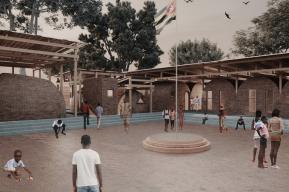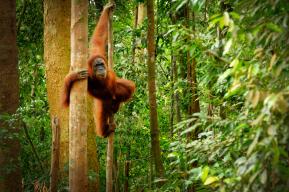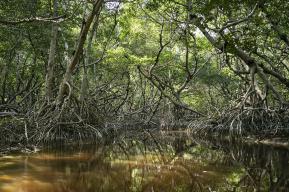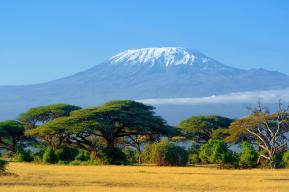文章
非洲:山地大猩猩归来

维龙加山脉的区域面积大约为450平方千米,刚果民主共和国、卢旺达和乌干达三国于此处接壤。在这片山林中,偷猎、疾病和森林砍伐曾导致山地大猩猩种群的生存岌岌可危。不过,当地社区及各方力量已经采取有效保护措施,使这一标志性物种的数量提升。
巴克·巴特·吕勒(Baker Batte Lule)
驻乌干达坎帕拉记者
就在不久前,乌干达布温迪“不可穿越的丛林”国家公园和姆加辛加大猩猩国家公园周边的社区还曾是大猩猩的死敌。生活在繁茂的绿色雨林附近的居民将大猩猩视为威胁,并且会在它们闯入自家花园时敲响警报,招呼四邻八舍来对付这些动物。本已濒危的山地大猩猩在这场争斗中几乎消失殆尽。
25年后的今天,大猩猩依然会到当地居民的花园中游荡,它们当中的雄性银背大猩猩可以长到6英尺高,重达500磅。居民们也依然还会敲响警报,但只是为了提醒公园管理员。在不受到威胁的情况下,这些大块头的家伙其实性情相当温和腼腆。目前,它们的种群数量已经从1998年的620只跃升到1063只。
大猩猩的数量已经从1998年的620只跃升到如今的1063只
鉴于大猩猩数量增长迅猛,国际自然保护联盟(IUCN)在2018年将其在《濒危物种红色名录》中的濒危等级从“极度濒危”下调为“濒危”。
山地大猩猩是现存体型最大的灵长目动物,也是体型相对较小、分布广泛的东非大猩猩的两个亚种之一。它们生活在高海拔地区,以自身特有的浓密深色毛发来抵御山上阴冷多雨的天气。
偷猎、滥砍滥伐和疾病
几十年来,大猩猩种群饱受各种威胁,这其中包括偷猎、栖息地森林的砍伐、人类疾病的传播和国家内战。种群数量的增加得益于积极的保护策略,例如持续监测、请兽医照料、治疗呼吸系统疾病、清除为捕捉其他小型动物而设置的陷阱,这会让大猩猩幼崽误入其中。
促使种群数量增加的另一个原因是大猩猩和当地社区之间的关系发生改观。安德鲁·塞古亚(Andrew Seguya)是当地致力于保护山地大猩猩的大维龙加跨界协作组织(GVTC)的执行主任,据他介绍,“过去的保护策略主要是约束当地人的行为。而现在,居民们将这些公园视为传世遗产的一部分,并愿意为公园的生存、扩展和管理出力献策。”
乌干达、卢旺达和刚果民主共和国境内都生活着大猩猩,三国政府和非政府保护组织共同结成了大维龙加跨界协作组织,其主要任务之一是在这一地区对山地大猩猩及其他物种开展普查。
专家指出,常规普查是适应性管理策略的重要内容。这项工作有助于确定种群数量的增减趋势,并评估保护工作是否有效,是否需要调整。
数据振奋人心
2019年12月,大维龙加跨界协作组织发布了《2018年布温迪—萨拉姆布韦调查》。从这最新一次的普查结果来看,在布温迪—萨拉姆布韦生态系统一带,包括乌干达境内的布温迪“不可穿越的丛林”国家公园(约321平方千米)和刚果民主共和国境内的萨拉姆布韦自然保护区(约9平方千米),生活着459只大猩猩,分为50个群居的族群和13只独居个体。自2016年以来,地跨乌干达姆加辛加国家公园、卢旺达火山国家公园(1983年被列为“联合国教科文组织生物圈保护区”)和刚果民主共和国维龙加国家公园的维龙加山脉共生活着604只大猩猩。
布温迪“不可穿越的丛林”在1994年跻身《世界遗产名录》,这是一片典型的热带雨林,蕴含着格外丰富的生物多样性。丛林的海拔在1160米至2600米之间,因植被茂盛繁密而得名。在这座国家公园的火山丛林中,生活着全球大约一半的山地大猩猩。
姆加辛加大猩猩国家公园则是乌干达境内面积最小的国家公园,面积只有34平方千米,与刚果民主共和国和卢旺达接壤。
旅游业带来大实惠
这些公园都是追踪观赏大猩猩的热门目的地。动物栖息地安全形势的改善在促进种群数量增加方面同样功不可没。塞古亚曾经在乌干达野生动植物管理局(UWA)担任执行董事6年,直到2018年3月卸任。据他介绍,在20世纪90年代后期,当地叛乱分子给大猩猩和旅游业带来了灭顶之灾:“旅游业的发展可以帮助政府创收,而政府又可以将这笔钱用于保护工作。”
旅游业是乌干达第一大创汇产业,2017年创收16亿美元,2018年创收20亿美元。由于疫情大流行,2020-2021财政年度(7月至次年6月)的收入预计将减少50%以上。
针对2020年4月24日的最新袭击事件——这是维龙加国家公园最近历史上最致命的一次——当时包括13名护林员在内的17人被疑似武装叛乱分子杀害,公园在一份声明中表示,“这一悲惨事件不会动摇公园携手公园周边社区共谋经济和人道主义发展计划并以此造福周边社区的决心。这些社区比以往任何时候都更渴望生活在稳定、公正与和平的气氛中。”
乌干达有10个国家公园和多处野生动物保护区,但大猩猩公园的旅游收入比其他所有公园加起来还要多。为了控制游客人数,大猩猩追踪许可证实行限量发放,8人一组进行参观,一天内每人每小时收费700美元。即便这样,游客们依然纷至沓来,一证难求。办下这张许可证在卢旺达要花费1500美元,在刚果民主共和国为400美元。
为鼓励社区伙伴的参与,乌干达政府通过了一项法律,规定乌干达野生动植物管理局必须将门票收入总额的20%分给公园周边的社区。
在乌干达,门票收入总额的20%要分给社区
这笔钱将作为有条件的补助金转交给地方政府,用于改善当地居民的生活。乌干达旅游、野生动植物和文物古迹部长戈弗雷·基旺达(Godfrey Kiwanda)表示:“收益共享的做法改善了我们与公园周边社区的关系。这些社区现在知道,络绎不绝的游客将为社区项目带来更多资金。我们已经用这些资金建起了学校和医院,还维修改造了当地的公路网。”
除收益共享之外,乌干达野生动植物管理局还协助社区开展其他创收活动。早在布温迪和姆加辛加的丛林被划定为国家公园之前,这里曾经是巴特瓦部落的家园——将巴特瓦人迁出他们的传统生存环境,意味着需要为这些人提供其他生计来源。在野生动植物管理局的帮助下,巴特瓦人开始种植咖啡和茶树,组建手工作坊,并将产品出售给游客。
非洲野生动植物基金会(AWF)等其他组织与布温迪丛林外围的恩古林哥社区合作,开办了一家生态旅馆,每年分享利润。非洲野生动植物基金会乌干达国家分会主任苏迪·巴穆莱斯瓦(Sudi Bamulesewa)说:“这个社区的替代性收入来源现在和大猩猩挂上了钩。一旦有了这种关系,大猩猩的数量必将大量增加。”
拓展阅读:
《拯救我们的近亲》,联合国教科文组织《信使》,2009年3月
《冲突后局势可能比冲突本身更糟》,联合国教科文组织《信使》,2006年12月
《濒临灭绝:正在消失的人类表亲》,《新信使》,2004年4月
订阅联合国教科文组织《信使》,阅读发人深省的时事文章,数字版免费。
在社交网络上关注联合国教科文组织《信使》:微博、微信公众号“联合国教科文信使”、Twitter、Facebook、Instagram。
Baker Batte Lule
Journalist based in Kampala, Uganda
There was a time, not long ago, when communities around Uganda’s Bwindi Impenetrable National Park and the Mgahinga Gorilla National Park were the mountain gorillas’ worst enemies. When the gorillas crossed their gardens, the inhabitants living close to these dense green rainforests would sound an alarm to confront the animals, who were viewed as a menace. This almost certainly resulted in the deaths of many endangered mountain gorillas.
Twenty-five years later, these great apes – of which the silverbacks, the males of the species, can grow to six feet tall and weigh up to 500 pounds – still wander through local gardens. But now if there are alarms, they only serve to alert park rangers. In fact, the numbers of these giants, who are gentle and shy unless threatened, have jumped from 620 individuals in 1998 to 1,063 today.
The number of gorillas has jumped from 620 individuals in 1998 to 1,063 today
This dramatic increase led the International Union for Conservation of Nature to downgrade the threat level for the gorillas on its IUCN Red List of Threatened Species – from “critically endangered” to “endangered” in 2018.
The largest living primate – one of two subspecies of the smaller, more ubiquitous, eastern gorillas – the Gorilla beringei beringei inhabits high altitudes. Mountain gorillas are distinguished by their thicker, darker fur that protects them from the cold and incessant rain of their habitats.
Poaching, deforestation, and disease
The gorilla population has suffered decades of extensive threats including poaching, habitat deforestation, disease transmission from humans, and civil conflict. Active conservation strategies – which include continuous monitoring and veterinary attention, the treatment of respiratory diseases, and the removal of snares set for other small animals which trap baby gorillas – have also helped the population increase.
The increase in numbers is also due to the links forged between the gorillas and the local communities. “In the past, the conservation strategy was based on constraints. But now, the inhabitants look at parks as part of their heritage, and hence contribute to their survival, expansion and management,” says Andrew Seguya, Executive Director of the Greater Virunga Transboundary Collaboration (GVTC), which protects the mountain gorillas.
A consortium of the governments of the three countries – Uganda, Rwanda and the Democratic Republic of the Congo (DRC) – where the gorillas live and non-governmental conservation organizations, one of the main tasks of the GVTC is conducting censuses for these and other species in the region.
Routine censusing is a crucial part of adaptive management strategies, experts say. The exercise helps determine whether a population is increasing or decreasing in size, and assessing whether conservation efforts are effective, or need to be modified.
Encouraging numbers
The coalition’s latest census, the Bwindi-Sarambwe 2018 Surveys, was released in December 2019. It shows that the Bwindi-Sarambwe ecosystem – that includes Uganda’s Bwindi Impenetrable National Park, which is about 321 square kilometres, and the Sarambwe Nature Reserve in the DRC, spanning about nine square kilometres – had 459 gorillas divided in fifty groups, and thirteen solitary individuals. The Virunga Massif – that includes Uganda’s Mgahinga National Park, Rwanda’s Volcanoes National Park (a UNESCO Biosphere Reserve since 1983), and the Virunga National Park of the DRC – had 604 gorillas as of 2016.
Inscribed on the World Heritage list in 1994, the Bwindi Impenetrable Forest is a typical tropical rain forest with an outstanding richness of biodiversity. Situated at an altitude between 1,160 metres and 2,600 metres above sea level, the thick tree cover gives the forest its name. The park’s volcanic hills are home to roughly half the world’s mountain gorillas.
The Mgahinga Gorilla National Park, on the other hand, is the smallest national park in Uganda – spread over just thirty-four square kilometres of land, and bordering both the DRC and Rwanda.
The benefits of tourism
All these parks are popular destinations for gorilla tracking. The improved security in their habitats has also contributed immensely to the increased numbers. Rebels in the area in the late 1990s had devastating effects on the gorillas and on tourism, explains Seguya, who was executive director of the Uganda Wildlife Authority (UWA) for six years till March 2018. “The development of tourism has helped the governments to earn resources which they can plough back into conservation,” he says.
Tourism is Uganda’s biggest foreign exchange earner, accounting for $1.6 billion in 2017, and $2 billion in 2018. Earnings are expected to decline by over fifty per cent in the 2020-2021 (July to June) fiscal year, due to the pandemic.
Referring to the latest attack on 24 April 2020 – the deadliest in the Virunga National Park’s recent history – when seventeen people, including thirteen rangers, were killed by suspected armed rebels, the park said in a statement that the tragic event would “not be allowed to undermine the Park’s commitment to economic and humanitarian development programmes in partnership with, and for the benefit of, the communities that surround the Park. More than ever, the communities aspire to live in a climate of stability, justice and peace.”
Although Uganda has ten national parks and a number of game reserves, the gorilla parks fetch more money from tourism than all the other parks combined. Gorilla tracking permits – which are rationed to curtail the number of visitors, and are in high demand – cost $700 per person for a group of eight people, for one hour a day. Permits in Rwanda cost $1,500, while the DRC charges $400.
To encourage community partnership, Uganda’s government has passed a law that makes it mandatory for the UWA to share twenty per cent of all gate collections from tourists with communities neighbouring the parks.
In Uganda, twenty per cent of all gate collections are shared with communities
This money is passed on to local governments as conditional grants to improve the livelihoods of the area’s inhabitants. According to Godfrey Kiwanda, Uganda’s Minister of State for Tourism, Wildlife and Antiquities, “The revenue-sharing has improved our relationships with the communities near these parks. They now know that if we have many visitors, it will result in more money for community projects. We have built schools, hospitals and improved the road network in their areas.”
Besides revenue sharing, the UWA has also helped communities to start other income-generating activities. Before they were gazetted national parks, the Bwindi and Mgahinga forests were home to the Batwa tribe – driving them out of their traditional habitats meant providing them with alternative sources of livelihood. The wildlife authority helped them to start growing coffee, tea and holding craft workshops, and selling the products to tourists.
Other organizations, like the African Wildlife Foundation (AWF), have teamed up with the Nkuringo community near Bwindi to construct an eco-lodge there, with profits shared every year. “This community now has alternative sources of income which are connected to the gorillas. Once you have that environment, the gorillas will multiply,” Sudi Bamulesewa, AWF’s Uganda country director said.











